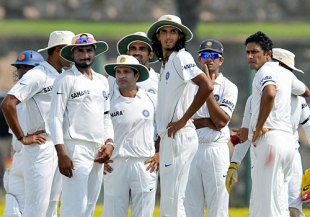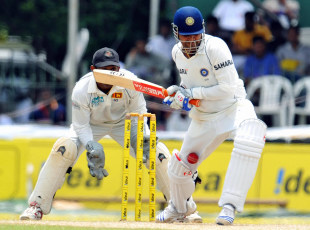
|

The jury is out: India have had more cause to feel aggrieved by the use of the review system than Sri Lanka so far
© AFP
|
|
After having been in use for all of two Tests, the review system now needs a review. There is no doubt that it needed to be tried, though it would perhaps have been preferable to have trialled it during the Champions Trophy, which is an ICC-run tournament, and where all the teams would have got a taste of it. But it can be argued that one-day cricket doesn't produce the sort of dismissals that would have tested the system to its fullest; and in fact, having used it in a Test series, the advantages and disadvantages have been exposed to a greater degree. To that extent, the trial has served its purpose already.
The results have been mixed. In the first Test, Sri Lanka benefited from the review process four times - twice justly, twice wrongly. No field umpire would have given
Sachin Tendulkar out to an edge behind his pads, which only the replays revealed; and
Rahul Dravid was so clearly out that it was a surprise the umpire didn't spot
the edge. Much-deserved justice for the bowlers on both occasions.
But Tillakaratne Dilshan benefited from lack of immediate visual evidence of a nick,
which had been spotted by the field umpire in the first instance. And then, far more
shockingly, Virender Sehwag was given out because of a human error from the third
umpire, and alarmingly, an error from the Virtual Eye system, which is expected to
produce reliable graphics. Rudi Koertzen, the third umpire in question, should have spotted the obvious deflection from the front pad onto the back one; Virtual Eye showed the impact to be in front of middle stump, but outside the crease. Sehwag was indeed hit outside the crease - on the front pad, which was in line with leg stump. The second impact was in front of middle stump, but the back foot was within the crease.
The system again invited some justifiable scepticism when it projected a ball from
Ajantha Mendis that pitched on middle and hit Gautam Gambhir in line with leg stump,
to be shaving leg. Of course, the umpires do not use the projection part of the
system, and Gambhir was ruled not out, but the doubts only grew.
The Indians might feel hard done by, but that's merely because they have
had more decisions going against them. And that's not really the point. They lost in
Colombo because they failed abysmally with the bat, the ball, and in the field. The
question before the administrators is whether the game is better served by the
review process.
| |
|
|
|
| |
| The review system exists to undo obvious wrongs, but it's clear that teams will ask for reviews simply because they have a few pending, and in some cases because bowlers always think that they have got their man |
| |
There is evidence, as acutely manifested during the morning session on the fourth day
of the Galle Test, that too many reviews can get tiresome and create major
interruptions in the game. There were four reviews in the session, and each
lasted four to five minutes. Sourav Ganguly, on being prompted by his batting
partner, won himself a reprieve, which would have seemed like justice to the Indians
after Dravid was given out - rightly, as it turned out - following a demand for a
review from the Sri Lankans. But Anil Kumble asked for a review when he was
stone-dead leg-before, and Sri Lanka made two unsuccessful reviews on leg-before
decisions.
More than 15 minutes were lost in a morning session which had been extended by half
an hour to make up for the lost overs on the first day. The review system exists to undo obvious wrongs, but it's clear that teams will ask for reviews simply because they have a few pending, as was evident from the Kumble instance, and in some cases because bowlers always think that they have got their man. In the first Test, Harbhajan Singh asked for one after the ball had pitched about half a foot outside the leg stump.
In all, 24 unsuccessful reviews are allowed in a Test. (The total number of reviews can, of course, be much higher.) And in the event of all of these being reviewed, and granting three to five minutes per review, anything between 90 minutes to two hours of play can be lost. That's between 20 to 30 overs. Can Test cricket afford to slow itself down even further?
This is not to argue that the system ought to be junked. Quite obviously, it allows edges
to be detected with greater certainty. In fact, the ICC ought to go a step further and
allow the use of the HotSpot technology, which has looked the most foolproof so far in detecting the impact of the ball. The super-slow cameras pick up the thick edges, but as
demonstrated by the Dilshan incident, they are not good enough for the thin ones. It
is understandable that not all television production companies would be inclined -
and they certainly cannot be forced - to use expensive technology, so it is incumbent
on the ICC, as the global custodian of the game, to employ and pay for the best
available technology at all international matches.
The matter is far more complicated with leg-before decisions. There is simply no
technology available to remove the subjective element, and indeed, if every ball that would go on to graze a stump were to be given out, matches may well finish in two days. It is also not clear what information is exchanged between the on-field and television
umpires. Does the television umpire merely communicate the information - the line of
the ball, the point of impact - or does he offer an opinion? And as evident from a
number of the reviews so far, despite multiple replays there remains an element of ambiguity about the final decision. If technology cannot provide an absolute answer, it is more likely to muddle the situation even further.

|

Sehwag became the first player to be given out when the on-field umpire's decision was overturned after review... wrongly, as it happened
© AFP
|
|
The only areas where technology can help are in cases of line decisions for lbws,
and edges, and it should be left at that. If it can be ascertained that a technology
can provide accurate pitch mats, then it must be used uniformly. To cut the delay,
on-field umpires could possibly be provided with handheld devices that allow them to view the pitch mats instantly. This will cut down the number of review appeals from the
fielding side.
It also needs to be clarified whether captains are allowed to seek an explanation
from the on-field umpire, as Mahela Jayawardene did before asking for the review of
Dravid's lbw, and how much time they have to make up their mind. Jayawardene was
within his rights to ask the umpire: if the review is being sought, it must be done
with knowledge of what evidence was used in arriving at the initial decision. The Indians
obviously missed a trick because Kumble consulted only his team-mates.
Of course, there is a view that cricket ought to be like baseball and football, two
highly televised, multi-billion-dollar sports, that haven't bowed to the pressure
of introducing technology into decision-making. But cricket made its call years ago. It is now impossible to imagine run-outs and stumpings being ruled on without a replay. And with a bit of fine-tuning and common sense, even the review system can be made to work.
Sambit Bal is the editor of Cricinfo

